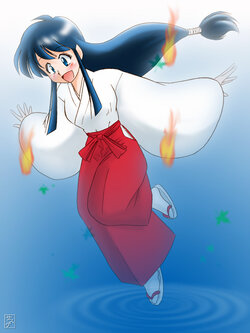
|
Moegirlpedia would welcome your assistance in improving this moe point-related article☆Kira~
Before editing this article, please read the wiki quickstart, editing guidelines and retrieve relevant information. We wish you a good time on Moegirlpedia. |
 | |
| Base Info | |
| Moe Point | Ghost |
|---|---|
| Symbolic Characters | Kinu Himuro |
A ghost is an imaginary creature and entity and also a moe point in ACG subculture.
Introduction
What is a ghost?
Ghost refers to the creature transformed by the soul after the death of a person or other creature. It is an imaginary form of life existence. Generally speaking, "ghost" refers to the ghost of a person, and "ghost" in a broad sense includes the ghosts that all living things turn into after death.
Around the world, in many countries and regions, there are concepts similar to ghosts. The Chinese concept of "ghost" is applied to the East, and a similar word in English is "Ghost". Ghosts are sometimes also called "dead souls", "ghosts", etc. The concept is very vague and can basically be regarded as the same existence. Traditionally in China, ghosts are also called " ghosts ". (Chinese ghosts and Japanese ghosts are completely different concepts)
What ghosts all over the world have in common is that they are living beings that are created by wandering around in the human world after the soul leaves the body.
Ghosts in ACG works mostly appear in supernatural and supernatural works, but only a few play major roles. Among them, the early representative figure is Kokinu, the second heroine of Ghost Sweeper Mikami.
In addition to some moegirls who are ghosts themselves, there are also some moegirls who are afraid of ghosts.
The emergence of ghosts
Ancient tradition generally believed that after death, the body decomposed, but the soul could still exist and could communicate with people in the world in some form (such as through dreams or embodiment). In different legends, the soul has different destinations after death, such as reporting to the underworld (underworld) to be reincarnated, or ascending into a higher being. The soul that has not gone to the place where it should go will stay and wander in this world. If it is contacted by people in this world, it is called a ghost.
Ghosts that remain in this world are generally considered to be those who still have nostalgia or resentment for this world, and still have unfulfilled wishes and are unwilling to leave.
Characteristics of ghosts
In legends from different places, ghosts have different image characteristics. Even the same local legend has different images after being circulated in different versions.
Invisibility
Traditionally, ghosts are invisible to ordinary humans. Humans see ghosts just like looking at air and cannot see their existence at all. Only some people with special abilities (such as Yin-yang eyes) can sense or even see the existence of ghosts. In some special circumstances, ghosts can materialize and appear in front of ordinary people. Ghosts usually look the same as they did in life.
This basic statement is applied in some ACG works.
Light weight
Traditionally, ghosts were thought to be very light or weightless, and could even float and move in the air. This basic statement is applied in some ACG works.
No feet
Different legends have different versions of whether ghosts have feet. Some versions have it, some don't. In the version without legs, the legs and feet are like wisps of smoke, getting thinner and thinner from top to bottom.
This basic statement is applied in some ACG works.
No shadow
It seems that this issue is mentioned only in Chinese legends. Ghosts have no shadows.
Possession
In many versions of the legend, ghosts can possess living people or corpses.
Since the ghost itself is the soul and does not have a body, after possessing a living person or a corpse and acquiring a body, it can walk and move like a human being.
Ghosts and the undead
The concept of "undead" is different from that of ghosts. There are two understandings of the concept of the undead (see also the article Undead).
- The first concept comes from the Japanese word yuurei (幽霊). The undead in this concept are also incorporeal, and can traditionally be regarded as the same concept as ghosts.
- The second concept is the free translation of the Western word "undead", which is usually translated as "undead". The undead in this concept have bodies, but their bodies have decayed, and their images are closer to those of zombies , zombies, etc.
However, in terms of the first concept, there are exceptions for a few works, such as Yuyuko Saigyouji in Touhou Project. Although it is close to the concept of a ghost, the author classifies it as an undead and emphasizes its difference from a ghost.
In addition, there are some living entities that are related to the concept of ghosts but are different from each other, such as resentful spirits, evil spirits, undead spirits, spiritual bodies, etc.
Characters with this moe point
- Kokinu (Ghost Sweeper Mikami)
- Murasa Minamitsu (Touhou Project)
- Napstablook, Mettaton (Undertale)
- Ghostfreak (Ben 10 series)
- The Flying Dutchman (SpongeBob Squarepants)
| ||||||||||||||||||||||||||||||||||||||||||||||||||||||||||||||||||||||||||||||||||||||||||||||||||||||||||||||||||||||||||||||||||||||||||||||||||||||||||
